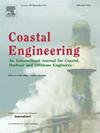Numerical study of orientation effects on hydrodynamics and loading in an array of structures under solitary wave impact
IF 4.5
2区 工程技术
Q1 ENGINEERING, CIVIL
引用次数: 0
Abstract
This study explores the impact of structure orientation on solitary wave-induced local hydrodynamics and loading in an array of structures, combining laboratory experiments and high-fidelity numerical simulations. Due to the complexity of the hydrodynamic processes involved, a comparative analysis of Reynolds-Averaged Navier–Stokes (RANS) k-ω SST and Large Eddy Simulation (LES) turbulence models’ performance was conducted using flume experiment data to identify the most suitable model. The LES model was chosen due to its superior capability to accurately capture high-frequency flow dynamics and resolve a broader spectrum of vortices. LES simulations were then performed on structure arrays arranged in two rows and three columns within a flat-bottom numerical flume. Structures were oriented at angles of 0°, 10°, 25°, 35°, and 45° clockwise relative to the incident wave direction, where orientation refers to the angle between the principal axis of an individual structure, centered around its cross-sectional centroid, and the direction of wave propagation. The results demonstrated significant effects of orientation on local hydrodynamics, including wave run-up, flow channelization, and vortex patterns. Symmetric orientations (0° and 45°) generated more uniform flow patterns, while asymmetric orientations (e.g., 25°) induced complex, irregular hydrodynamics. The 45° orientation yielded the highest normalized surface velocity due to greater flow blockage. Vortex dynamics varied significantly with orientation, with certain configurations enhancing mixing and energy dissipation within the structure arrays. The pressure and force analysis revealed distinct shielding effects of front-row structures for those in the back row across orientations. Seaside walls experienced the highest forces, while sidewall forces increased with orientation angle as they became more exposed to the wave. Conversely, forces on the opposing sidewall decreased with greater angles as they became more sheltered. The maximum net force increases with orientation, reaching 49 % higher in the front row and 18 % in the back row at 45° angle. Back-row structures consistently experience greater net forces primarily due to leeside pressure reduction from channelized flow and resulting wake vortices. This study underscores the critical role of structure orientation in coastal design and highlights the potential for optimizing array configurations to withstand diverse wave loading scenarios.
对孤波冲击下结构阵列的流体动力学和加载的定向效应的数值研究
本研究结合室内实验和高保真数值模拟,探讨了结构取向对孤立波诱导的局部水动力和一系列结构载荷的影响。由于所涉及的水动力过程的复杂性,利用水槽实验数据对reynolds - average Navier-Stokes (RANS) k-ω SST和Large Eddy Simulation (LES)湍流模型的性能进行了比较分析,以确定最合适的模型。之所以选择LES模型,是因为它具有更强的能力,可以准确捕捉高频流动动力学并解析更广泛的涡旋。然后在平底数值水槽内对两排三列结构阵列进行了LES模拟。相对于入射波方向的顺时针方向分别为0°、10°、25°、35°和45°,其中定向是指以剖面质心为中心的单个结构的主轴与波传播方向之间的夹角。结果表明,定向对局部流体力学有显著影响,包括波浪上升、流道化和涡型。对称方向(0°和45°)会产生更均匀的流型,而不对称方向(例如25°)会产生复杂、不规则的流体力学。由于更大的流体堵塞,45°定向产生了最高的归一化表面速度。旋涡动力学随方向变化显著,某些构型增强了结构阵列内的混合和能量耗散。压力和力分析表明,前排结构对后排结构的屏蔽效应明显。海边墙壁受到的力最大,而侧壁受到的力随着朝向角的增加而增加。相反,当侧壁变得更加隐蔽时,对侧壁的力随着更大的角度而减小。最大净力随着方向的增加而增加,在45°角时,前排的净力增加49%,后排的净力增加18%。后排结构始终承受更大的净力,这主要是由于通道化流动和尾流涡导致的背风侧压力降低。这项研究强调了结构方向在海岸设计中的关键作用,并强调了优化阵列配置以承受不同波浪载荷情景的潜力。
本文章由计算机程序翻译,如有差异,请以英文原文为准。
求助全文
约1分钟内获得全文
求助全文
来源期刊

Coastal Engineering
工程技术-工程:大洋
CiteScore
9.20
自引率
13.60%
发文量
0
审稿时长
3.5 months
期刊介绍:
Coastal Engineering is an international medium for coastal engineers and scientists. Combining practical applications with modern technological and scientific approaches, such as mathematical and numerical modelling, laboratory and field observations and experiments, it publishes fundamental studies as well as case studies on the following aspects of coastal, harbour and offshore engineering: waves, currents and sediment transport; coastal, estuarine and offshore morphology; technical and functional design of coastal and harbour structures; morphological and environmental impact of coastal, harbour and offshore structures.
 求助内容:
求助内容: 应助结果提醒方式:
应助结果提醒方式:


